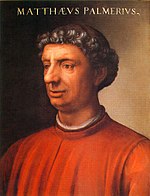Matteo Palmieri
| Portrait of Matteo Palmieri | |
|---|---|
 |
|
| Artist | Cristofano dell'Altissimo |
| Year | after 1552 |
| Medium | Oil on wood |
| Dimensions | 60 cm × 40 cm (24 in × 16 in) |
| Location | Uffizi Gallery, Florence |
Matteo di Marco Palmieri (1406–1475) was a Florentine humanist and historian who is best known for his work Della vita civile ("On Civic Life"; printed 1528) which advocated civic humanism, and his influence in refining the Tuscan vernacular to the same level as Latin. He was sent as Florentine ambassador to the court of Alfonso of Naples. Vespasiano da Bisticci included him among the illustrious men of his generation whose careers deserved an article in his Vite di uomini illustri del secolo XVvita.
Palmieri was born to a middle-class family who held prominent positions in the city. He was educated in Florence and ran a profitable apothecary shop; like his father he pursued a career in civil service, becoming a well known and respected public official between 1432 and 1475 holding many posts and titles.
At the end of his life, he commissioned from the florentine painter Francesco Botticini (1446 – 1498) a monumental Assumption of the Virgin for the church of the Benedictine nunnery of San Pier Maggiore in Florence, where the Palmieri had their chapel; in the painting are the kneeling donor portraits of Matteo and his wife Niccolosa de' Serragli.
Palmieri firmly believed in the humanist ideal that virtù was a combination of both learning and political action, and so in concordance with his political life, he was also an author. He wrote in both Latin and Italian. Among his Latin works are Liber de temporibus (Book of Epochs), a universal chronicle of the world from the time of creation to his present day; the De captivitate liber (The Capture of Pisa), an account of the Florentine capture of Pisa in 1406; and a biography of Niccolò Acciaioli, translated to Italian by Donato Acciaioli.
...
Wikipedia
